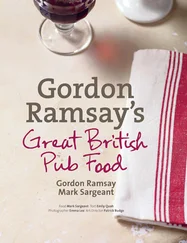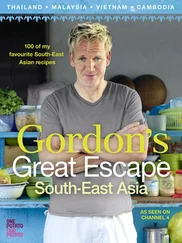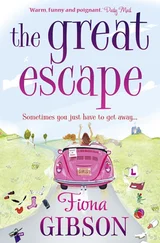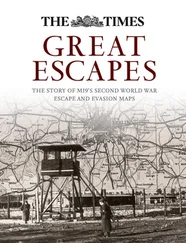Gordon Ramsay’s Great Escape
Food Mark Sargeant Text Emily Quah
 HarperCollins Publishers
HarperCollins Publishers
Cover Page
Title Page Gordon Ramsay’s Great Escape Food Mark Sargeant Text Emily Quah HarperCollins Publishers
Introduction
Glossary
Starters & Snacks
Fish
Poultry & Meat
Vegetarian
Breads & Rice
Chutneys & Accompaniments
Sweets & Drinks
Index
Acknowledgements
Cook’ Note
Copyright
About the Publisher
Over 3.5 million curries are eaten in the UK each year, which shows how much Indian cuisine is now part and parcel of the British diet. My own love affair with Indian food started when my mother made me my first curry as a child. Granted, mum’s inauthentic curries were nothing like what we’re used to today – hers were mostly flavoured with curry powder with the occasional handful of sultanas thrown in – but to us the flavours seemed exotic and mesmerising and I was hooked.
Since I left home and started working, Friday-night curries have become a ritual. Like most people, I have had favourite dishes, which I would order time and again, but overall I felt pretty comfortable with the food and thought that I knew quite a bit about Indian cuisine. How wrong I was! I had never been to India before this trip, and what little I knew about the country and its food was based on general stereotypes and preconceptions. I now realise that it is impossible to summarise the food of a vast subcontinent where differing cultures, religion, topography, climate and history all influence what food is eaten and how it is cooked.
When the opportunity came for a culinary adventure in India, the choice was simple. This was the chance of a lifetime to escape from the grind of daily life and discover the truth about Indian cuisine. I knew that real Indian food was not to be found in fancy restaurants and hotel eateries; instead I had to travel the country and eat as ordinary Indians do, regardless of caste, class or religious differences.
My journey started in the north, in the capital of New Delhi, home to 17 million residents. As I entered the city the first thing that struck me was the sheer contrast of wealth and severe poverty that was apparent everywhere, but I soon noticed that no matter what the individual situation was, almost everyone had a beaming smile. The Delhi residents also seemed to be working constantly, day and night; however, amid the hustle and bustle, I got a real sense of organised chaos that I had never experienced anywhere else before. In fact, this was the feeling I got in almost every Indian city to which I travelled, but Old Delhi was certainly a culture shock. The sights at the Red Fort were wonderful, and there were beautiful temples everywhere you looked, but, in the middle of it all, I was amazed to see rows of fragile-looking shacks that sold everything from mobile phones and shoes to food and Honda motorbikes!
Navigating and crossing the streets of Delhi proved to be a big challenge. The roads were filled with maniacs who drove wherever they chose with utter disregard for any street signs, regulations or pedestrians! There was a constant echo of horns beeping the whole time as every driver felt that he had the right of way. For me, the most amusing sight had to be the occasional herd of cows meandering along the streets, oblivious to oncoming traffic, while taxis, cars, motorbikes and tuk tuks did their best to avoid hitting the sacred animals.
Where food was concerned, my most memorable meal in Delhi was at the legendary Moti Mahal restaurant in Daryaganj, where classics such as tandoori chicken and butter chicken (one of my all-time favourites) were invented over 60 years ago. It was here that I met Seema Chandra, a renowned food writer and critic, who explained to me that the food in India is truly different from the Indian food that you get in Britain. This was clearly evident in the dishes at Moti Mahal: the delicious butter chicken was very moist, tender and flavour-some – unlike anything I’ve ever tasted. According to Seema, real Indian food is found on the streets and in family homes. Indians have not historically had a big restaurant culture, although this has now changed, and (for those who can afford it) eating out has become a popular pastime. Many homes have servants or mothers and grandmothers who prepare fresh, delicious meals for the entire family three times a day. Workers who do not have time to go home for lunch pick up cheap, delicious street food to sustain them until they can get home for dinner; children bring their lunches to school carefully packed in multi-tiered tiffin carriers, and shoppers indulge in street snacks before going home for their main meals. This emphasis on traditional home cooking means that recipes have been passed down from generation to generation and have seldom been well recorded, so if I wanted to get a true flavour of Indian cookery, I needed to roll up my sleeves and get my hands dirty.
One of the first things I learnt was that food is very important in India. Even the very poor will find a way to eat well with cheap but delicious meals. I understood this on board the Mangalore Express, on my way to Lucknow, the foremost city of food and culture. To earn my fare I was given an apron and immediately set on the task of prepping vegetables in the train cafeteria. There, a team of five chefs and 20 waiters make and serve fresh meals to over 400 passengers each day. For an equivalent of £110 a month, the chefs work 10 hours a day, 6 days a week in the most challenging of work environments. Pots constantly rattled and the portable stove shifted with the movements of the train. Nonetheless, they took great care to produce
hot, tasty and satisfying meals for the masses – a far cry from the pitiful, factory-made train food we have in the UK.
Lucknow was another revelation in terms of food. The city is famous for its exquisite cuisine and it is known as the birthplace of the korma and biryani. The original korma is a totally different dish from the British version, made lighter with yoghurt instead of cream and thickened with a paste made from ground almonds instead of coconut milk. The resulting dish was absolutely delicious, but it was a dark brownish-red colour instead of the creamy yellow to which we are accustomed. More remarkable were the biryanis, served at every festival and celebration. I had the privilege of spending a day with master chef, Imtiaz Qureshi, who in his heyday had catered for over 50,000 guests for a single event. We cooked dum ba biryani , a complex dish sophisticated enough to serve emperors and maharajahs. Similar in concept to a three-bird roast, this dish entailed two whole goats, four chickens and four quails stuffed with saffron-marinated quails’ eggs. The stuffed goats were then placed on a bed of biryani rice and meatballs, and the cooking pot was sealed with pastry to capture the aromatic flavours of the dish as it was finished off. A truly amazing biryani that you are unlikely to find in any cookery book (so I just had to include it in this one, see page 179)!
After experiencing the rich and indulgent food of the north, I went in search of back-to-basics cooking, and in unfamiliar territories. My travels took me to the poor, remote district of Bastar in the central state of Chhattisgarh. Here the local speciality is chakra , a delicious hot and tangy chutney made with chopped red chillies, salt, ground fresh ginger and a secret key ingredient: local ants! For obvious reasons I haven’t included the recipe in this book, but the local tribe has taught me what it really means to live off the resources of the land. Every single ingredient is sourced locally, and with the lack of refrigeration there is a strong emphasis on fresh produce.
Читать дальше
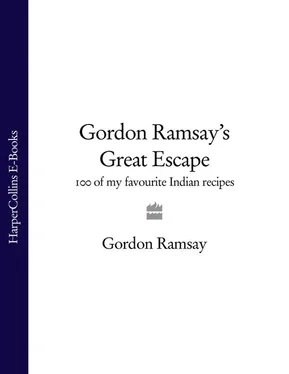
 HarperCollins Publishers
HarperCollins Publishers
